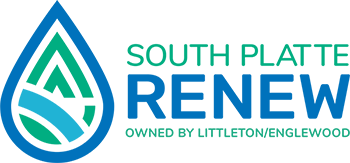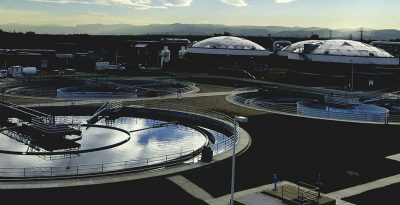
The sewage collection system and treatment facilities for Englewood and Littleton cities developed separately but in a similar manner. The collection system follows the natural drainage pattern in the area that leads to the South Platte River. The overall service area includes both cities' own collection systems and systems built and maintained by 19 connector districts.
City of Englewood

In the early 1950s, the Englewood Wastewater Treatment Plant was built at Santa Fe and Bates Avenue. The plant treated sewage from the Englewood service area and discharged treated effluent to the river. The treatment process was a very simple trickling filter plant — headworks, primary clarifier, trickling filters, secondary clarifier, anaerobic digesters, and support facilities. Between the original construction and 1971, the plant was expanded several times.
The final version of the Englewood WWTP had a north and a south plant with a 15 mgd (million gallons per day) treatment capacity. The original south plant was expanded to include a secondary process and disinfection. The newer north plant was a simple trickling filter plant similar to the original south plant.
City of Littleton

The Littleton Wastewater Treatment Plant was originally built in the late 1940s in the vicinity of Santa Fe Drive and Belleview Avenue. This facility was also expanded several times and, by 1976, was treating 5 mgd (million gallons per day) to secondary standards before discharging into the South Platte River. to secondary standards before discharging into the South Platte River.
Both plants needed upgrades to meet the new regulations; however, the newly formed Environmental Protection Agency (EPA) preferred to combine treatment needs at one larger facility rather than spend the money to improve two old, smaller facilities. Negotiations and planning for a new regional facility began in 1973. The result of this work was the Littleton and Englewood Regional Joint Use Wastewater Treatment Facility. The Englewood WWTP and the Joint Use Plant were known as the Bi-City Plant.
Since both service areas flowed by gravity to the Englewood WWTP site, the plant was situated at this site. The Joint Use Plant was rated for 20 mgd using a pure oxygen system to support the biological treatment process. The plant was conceived as a modern, computer-controlled facility capable of meeting advanced treatment requirements. The site and physical layout of the plant was to accommodate an ultimate capacity of 50 mgd. The new plant was primarily funded by an EPA grant, a state grant, and local funds. A portion of the funding was for innovative technology. The total cost of the new facility was $22,556,000, including the EPA grant of $13,000,000. The plant was constructed in the mid-'70s, removing the two older treatment plants from service. The operation of the plant began in April 1977.



